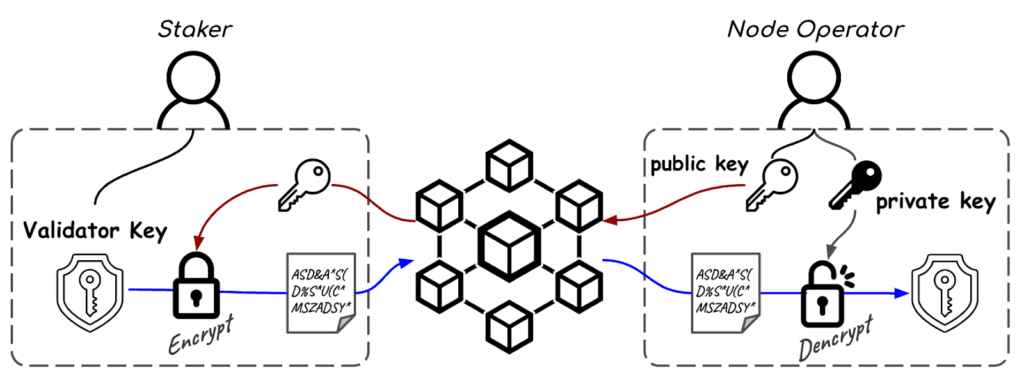Ether.fi is a self-proclaimed non-custodial ETH staking platform that enables users to distribute their staked ETH to node operators for rewards without having to reveal their private key information.
This is achieved through using a shared validator key that uses an integrated encryption scheme (ECIES). Stakers generate encrypted validator keys that are associated with a winning bid generated by a node operator public key. This then forwards information back to the node operator who can decrypt the information using a registered private key.

Source: Ether.fi
This is different from staking with Lido, or centralized node operators, Mike Silagadze, the CEO of Ether.fi, told Blockworks.
“The way it works is you send them your ETH and they generate the private keys that control the keys,” Silagadze said. “There’s a trust assumption that they will return their ETH to you.”
By contrast, Ether.fi ensures that stakers generate their own private keys — stakers only share an encrypted copy of their key with validators.
This does not mean that a staker’s ETH is safe from slashing conditions, as their ETH is still being used to operate the nodes.
So what is Ether.fan?
Ether.fan is Ether.fi’s membership loyalty program, built on top of its liquid staking token eETH.
EETH — like most liquid staking derivatives (LSTs) — enables users to participate in securing the Ethereum network while also actively participating in DeFi activities without having to lock up 32 ETH.
With Ether.fan, users can stake ETH and mint a fan NFT. The process involves converting the user’s ETH into eETH, which is then wrapped within an NFT. This NFT not only represents ownership, but it also contains rewards and membership points for the user.
“It’s designed for people that have smaller amounts of ETH,” Silagadze said. “We want a product that is usable by the average person rather than just being limited to institutions.”
Fundamentally, this means that a fan NFT is simply a wrapped staked ETH that accumulates rewards over time. The longer a user holds the NFT, the more loyalty points they will gain. The higher the loyalty points, the greater the amount of yield and rewards the user will receive.
There are 4 membership tiers: bronze, silver, gold and platinum. Different tiers will have different rewards.
“We copied the airline model basically,” Silagadze said. “The model is you’re collecting airline points and you’re either cashing them in or selling them.”
If a user withdraws ETH, their membership status will be bumped down, Silagadze notes. If a user plans to withdraw more than 50% of their ETH, the platform will burn their NFT.
“It makes more sense to sell the NFT [on] like OpenSea or something so that you get to capture the premium,” Silagadze said.
Ether.fan NFTs will also have a role in governance, allowing users to participate in Ether.fi governance without the protocol having to issue its own native token.
All ETH that goes through Ether.fan will also go to solo stakers, Silagadze notes.
“It goes towards launching Ethereum nodes in diverse geographies, because right now Ethereum is actually quite centralized when it comes to where the nodes are located,” he said. “We’ve launched the first node in Guatemala and we have others that are in the queue.”


